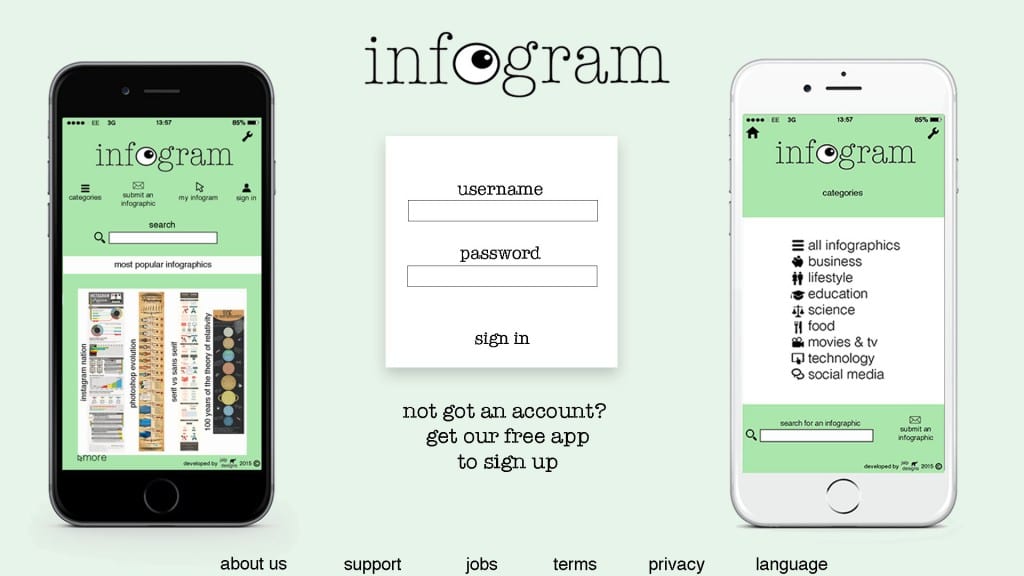This is my final infographic design. A ‘100 years of The Theory of Relativity’ infographic. I am happy with this final design and I feel it does everything I wanted it to when I was first thinking of ideas. It is doesn’t have too much information but still tells you the basics of the theory – making it less confusing and easier to read. My original audience was undergraduates before I started but now I feel it could appeal to a range of ages because of it’s theme of ‘100 years’ celebration. It could appeal to kids who want to know some fun facts on Einstein, teenagers who are studying GCSE science to get an idea on basics of the theory or even undergraduates and postgraduates who know of 2015 being the 100 year point and come across this infographic.
Month: November 2015
Online Desktop Final
Mobile Desktop Final
These are my final designs for the mobile desktop output. I have created a design for an app called ‘Infogram’ – an app that holds thousands of infographics. I have created a home page design which features a ‘most popular’ section with my own infographic. Then there is a menu with several categories that the infographics come under. Then the page where my own infographic is held which I have repeated three times to show a different section of the infographic as the user would have to scroll down the page to see it all. Then I have an icon for the app.
Infographic – Work in Progress
 At this stage I have added a large bulk of information to my design and I feel like it is a reasonable amount and doesn’t look too crowded. I need to adjust the top part with the Einstein facts as I am not 100% sure how to present this part. I was thinking of continuing with facts down the sides of the infographic but I don’t want to overload it. I am also wanting to add small cartoon style images down the sides such as rockets, astronauts, asteroids, stars, etc.
At this stage I have added a large bulk of information to my design and I feel like it is a reasonable amount and doesn’t look too crowded. I need to adjust the top part with the Einstein facts as I am not 100% sure how to present this part. I was thinking of continuing with facts down the sides of the infographic but I don’t want to overload it. I am also wanting to add small cartoon style images down the sides such as rockets, astronauts, asteroids, stars, etc.
 I found an image of Einstein here – which I edited to remove the background and once I added it to the infographic I removed more of the image and took the opacity down. In terms of fonts I have added another one for the ‘did you know?’ text (which I am still unsure of) which is a font called gimme space from dafont.com. I am pleased with the way the infographic is coming along so far but I still feel like I’ve got a lot to do with it yet.
I found an image of Einstein here – which I edited to remove the background and once I added it to the infographic I removed more of the image and took the opacity down. In terms of fonts I have added another one for the ‘did you know?’ text (which I am still unsure of) which is a font called gimme space from dafont.com. I am pleased with the way the infographic is coming along so far but I still feel like I’ve got a lot to do with it yet.
I have now added more facts to my infographic and spread them around the page. This left spaces that
 needed to be filled so I decided to add some imagery. For these I mainly found an image on Google and then traced over it on Photoshop. For the asteroid and galaxy images I went to a royalty free website (here) and found this image and this one. I then removed the background on them and added that to my infographic. After positioning these around the text I felt my infographic was finally finished. I think that adding too much more would make it too crowded and over done. It isn’t overloaded with information, making it clear to read and understand. It also isn’t too serious with the fun facts I’ve added and the cartoon style imagery gives a fun touch.
needed to be filled so I decided to add some imagery. For these I mainly found an image on Google and then traced over it on Photoshop. For the asteroid and galaxy images I went to a royalty free website (here) and found this image and this one. I then removed the background on them and added that to my infographic. After positioning these around the text I felt my infographic was finally finished. I think that adding too much more would make it too crowded and over done. It isn’t overloaded with information, making it clear to read and understand. It also isn’t too serious with the fun facts I’ve added and the cartoon style imagery gives a fun touch.
Infographic research – Relativity
Now I have started putting my infographic together I have been referring back to my previous research on The Theory of Relativity where I made a post on what I could include in the infographic. However, I am now feeling that I need more research as I have made an infographic that is 15cm by 45cm and I need enough to fill this. I also plan on having a small section that has some ‘did you know’ facts about Einstein before going into the theory as I am creating a ‘100 years of the theory of relativity’ infographic and feel like it is needed. Therefore I’ll be researching into him as a person and scientist, too.
One of the first points I wanted to talk about in the infographic was the difference between special and general relativity.
In 1905, Albert Einstein determined that the laws of physics are the same for all non-accelerating observers, and that the speed of light in a vacuum was independent of the motion of all observers. This was the theory of special relativity. It introduced a new framework for all of physics and proposed new concepts of space and time.
Einstein then spent 10 years trying to include acceleration in the theory and published his theory of general relativity in 1915. In it, he determined that massive objects cause a distortion in space-time, which is felt as gravity.
Special Relativity: the laws of physics are the same for all non-accelerating observers. The speed of light in a vacuum is independent of the motion of all observers.
General Relativity: this theory brings in acceleration. It determines that massive objects cause a distortion in space-time, which is felt as gravity.
I then opened as many web pages on ‘the theory of relativity’ that I could find, picking out all the information I wanted to use in my infographic.
‘8 ways you can see Einstein’s theory of relativity in real life‘
The implications of Einstein’s most famous theory are profound. If the speed of light is always the same, it means that an astronaut going very fast relative to the Earth will measure the seconds ticking by slower than an Earthbound observer will — time essentially slows down for the astronaut, a phenomenon called time dilation.
There’s also some other examples in this article that I can use but as my infographic design features planets and space I thought the astronaut one would work the best.
General relativity predicts that even light is deflected by gravity – a prediction that has been confirmed by numerous astronomical observations. In addition, it predicts exotic phenomena like gravitational waves and black holes.
– Einstein Online
Facts about Einstein: I found an article called ‘20 facts about Albert Einstein‘ and I picked a few that I could use.
- He failed his university entrance exam and had to re-apply a year later.
- Einstein never received a nobel prize for relativity. It was actually for the photoelectric effect.
- He did not like to wear socks.
- He married his first cousin
- He was offered the position of President of Israel, but he declined
As well as random facts I wanted to include a brief introduction of who he was, which I got from Wikipedia:
Albert Einstein (14 March 1879 – 18 April 1955) was a German-born theoretical physicist.
He received the 1921 Nobel Prize in Physics for his “services to theoretical physics”.







